"Magic mirror on the wall, who's the fairest one of all?" -the Wicked Queen
For a galaxy, though, it's really not fair to ask which one's the fairest. It's simply too subjective of a question. But size, now that's something we can measure.
So, I ask you -- galaxies of the Universe -- to step forward and show yourselves! Galaxy, galaxy on the wall, who's the largest one of all?
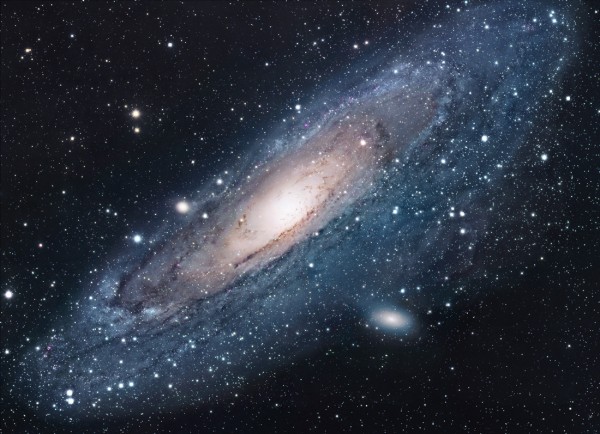
Nice try, Andromeda. Our biggest sister, Andromeda, has about 400 billion stars that make her up. That's about 50% more than our Milky Way has, and it makes Andromeda the largest galaxy in our local group. Andromeda is about 2 million light years away from us.
But those are some small potatoes. If we want to find a bigger galaxy, we need to look at a bigger group of galaxies. Let's try out the closest cluster to us...

The Virgo cluster! If we want the biggest one, we go straight to the heart of the cluster, which is where the giant elliptical galaxy -- M87 -- lives.
So let's take a look at M87!

55 million light years distant, M87 is the largest and brightest galaxy in the Virgo cluster, and is notable for the huge, 5000-light-year-long jet coming from the supermassive black hole living at its core!
This galaxy is tremendous in its physical size: about 500,000 light-years in radius. As far as its massiveness, it's about 200 times as massive as the Milky Way, or about 50 trillion times as massive as our Sun.
But what if we go to even bigger clusters than Virgo? Some of them are like the Coma Cluster, below.
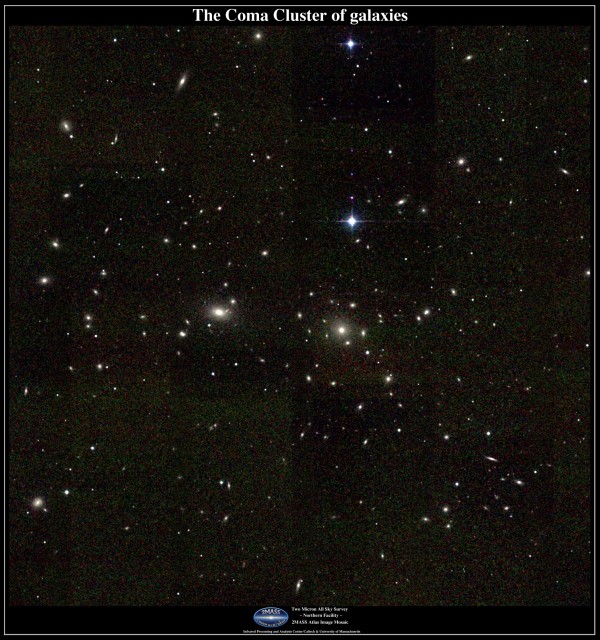
The cluster is larger than Virgo, but what about its largest galaxy? Well, there are two giant elliptical galaxies close to its center, NGC 4889 and NGC 4874, easily visible in the above image. But even combined, they only add up to 20 to 30 trillion times the mass of our Sun.
On the other hand, there are spectacular galaxy clusters like the Perseus Cluster, which I'll show you below.
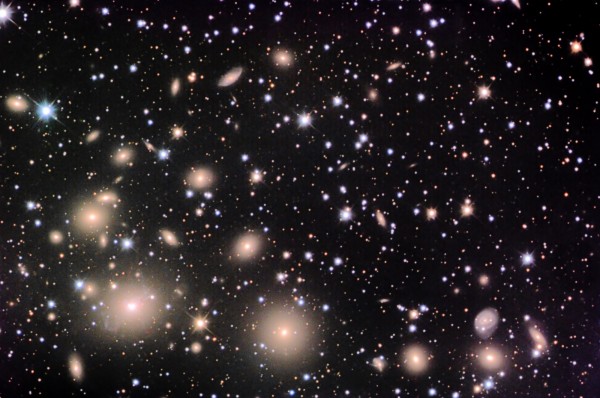
Well, if we look at the heart of the Perseus cluster, we find the galaxy Perseus A, also known as NGC 1275. This is one spectacular galaxy:
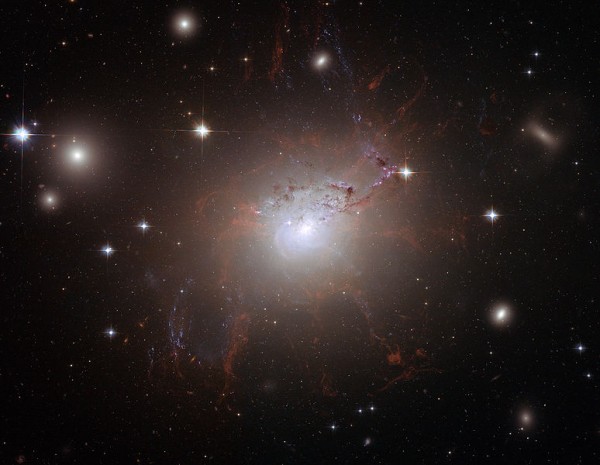
(There's a huge version of this, from Hubble, of course, available here.)
At a distance of 237 million light years, it's really quite far! And while it is hugely bright in its X-ray emissions, it's only about 100,000 light years in radius; only about 3 times the size of our Milky Way!
So some of these galaxies at the hearts of clusters are supermassive, loaded up with the matter from trillions of Suns in them, but others are much more modest.
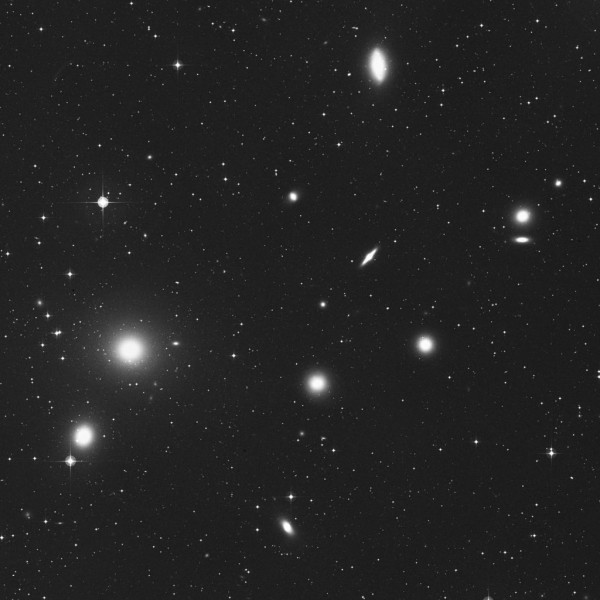
So we go around, finding galaxy clusters, and look for giant, centrally-dominant elliptical galaxies in them. (Fornax, dominated by NGC 1399, is shown above.) And we measure their angular size, their light, and try to infer their masses.
So enough with the suspense, already! Who wins?
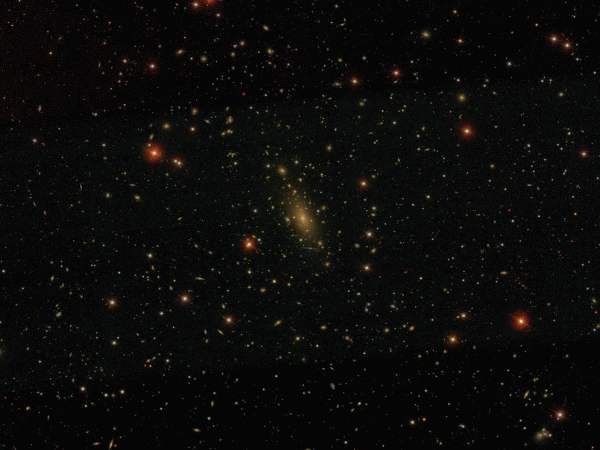
Say hello to cluster Abell 2029, a supercluster of galaxies just over a billion light years away. If we look at the heart of Abell 2029, we find the largest, most monstrous galaxy ever observed, IC 1101.
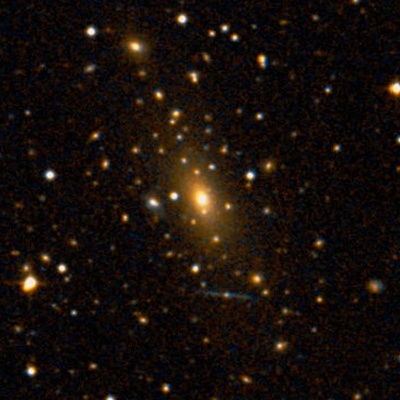
IC 1101 is 5 to 6 million light years across, or about 5 times larger in radius (and hence about 125 times larger in volume) than the huge M87!
Estimates of its mass are close to a quadrillion solar masses, with an estimated 100 trillion stars!
And -- as of right now -- it's the largest galaxy we know of in the entire Universe. Enjoy!

OK, I'll bite- what would be the local conditions inside such a supermassive galaxy? Are they notably dense? What would local radiation levels be like? Are they highly likely to spawn supermassive, unstable stars? Are they then hotbeds for supernovae, neutron stars and black holes and their attendant radiations?
Such extremes are very intriguing.
I don't know the answers to all of Proper Gander's questions, but I can answer the one about star formation: Not happening to any significant extent. The galaxy-galaxy collisions which form elliptical galaxies tend to use up any remaining free dust/gas in a burst of star formation, and few stars form until the next time this galaxy collides with a spiral galaxy. You will see lots of supernovae if you look during a certain window of time after the collision when the massive stars formed during the collision exhaust their fuel. I can speculate that you will see lots of neutron stars if you look after (or toward the end of) the supernova window. I don't know enough about how to produce stellar mass black holes to comment on that one (most supernovae blow off enough mass to leave a core with less than the 3 solar mass limit for neutron degeneracy pressure to overcome gravity).
IC 1101, That's big...that's really big.
So it's a lenticular galaxy as we see it now in 2010, a billion light years ago.
It may be a spiral by now?
What term does an astrophysicist use to indicate present evolutionary status of a distant object, not the past illusion of an earlier universe with incoming information (photons,ect.)that we use for analysis.
I thought the latest finding was that the Milky Way and Andromeda were about the same size (which was not the generally accepted conclusion prior to about a year ago). See http://news.bbc.co.uk/2/hi/science/nature/7813635.stm
Thanks for explaining this and the globular cluster ideas.
Very nice. I did not know.
In the search to answer my question I've learned that cosmologist and astrophysicist refer to the observable Universe compared to the term Universe. That is not very descriptive as I would call them the Apparent observable and the Present Unobservable Universe.
But then I read that recently Alexander Kashlinksy says,
(about a commen motion of galaxies of at least 600 km/s toward a 20-degree patch of sky between the constellations of Centaurus and Vela).
"At this point we don't have enough information to see what it is, or to constrain it. We can only say with certainty that somewhere very far away the world is very different than what we see locally. Whether it's 'another universe' or a different fabric of space-time we don't know."
Since nothing but the geometry of space can move faster than light, everything we see has happened in the past, the beer that I am reaching for, by the time I raise it to my lips it is no longer exactly as I seen it, even before we are able to process this information time has elapsed.
There is a claim that it's possible to see a galaxy more than once as it's image circumnavigates the Universe and delivers the info from an earlier time. IF this is correct then extrapolating the (present) state or the Present unobservable Universe could be far more difficult to construct than even the positions and movements of every star in a GC.
How would you know that you are receiving duplicated and time separated info on the same object, this is quite strange.Nothing is as it seems, we really are living a life of illusion
What of this Dark Flow?
The photos are beautiful. I wonder how far they are and how wide the galaxies are.
Since nothing but the geometry of space can move faster than light, everything we see has happened in the past, the beer that I am reaching for, by the time I raise it to my lips it is no longer exactly as I seen it, even before we are able to process this information time has elapsed.
And to think, the universe is only 7000 years old and god took only 1 day to create all the stars. That means IC 1101 was created in less than .0000000000000000000000000000000001 seconds.
nd that's only if I remember and understand it all correctly.
I just did, what happened to it?
Yort, all the matter in the universe was created in a single instant called the big bang, but before the big bang there was nothing.
"In physics, the law of conservation of energy states that the total energy of an isolated system cannot change—it is said to be conserved over time. Energy can be neither created nor destroyed, but can change form, for instance chemical energy can be converted to kinetic energy in the explosion of a stick of dynamite.
A consequence of the law of conservation of energy is that a perpetual motion machine of the first kind cannot exist. That is to say, no system without an external energy supply can deliver an unlimited amount of energy to its surroundings." (Planck, M. (1923/1927). Treatise on Thermodynamics, third English edition translated by A. Ogg from the seventh German edition, Longmans, Green & Co., London, page 40)
How did nature/chaos/laws of physics, after CREATING all this stuff from nothing, then establish a law such as this?
The flip side of this is, when God spoke, he transformed energy from himself to create all we see before us?
God spoke, BANG!!! it was there.
Just an alternative opinion as all, I do not claim to know all, I am no god.